Imagine that you have defined a Model component for a normal lay configuration and a range of applicable environmental conditions. Your objective then is to optimise the configuration for a specific tension at the vessel and to check its dynamic response. This means that you are going to have to define static and dynamic analyses of your system. The following article shows how you might accomplish this in a typical case.
If you have not already done so, you will have to create a new Analysis component. The Properties tab will be to the forefront by default. At this early stage, you only have to select your Model component from the drop-down list provided. The other inputs can be ignored.
It is normal for a lay operation to be performed in a series of distinct stages and PipeLay reflects this. The figure below shows the Installation Stages tab before any stages are defined.
A good first step for any configuration is to check it statically without environmental loads. Not coincidentally, this corresponds to the defaults on the Installation Stages tab. Click Add to create a static stage. The figure below shows the Installation Stages tab afterwards.
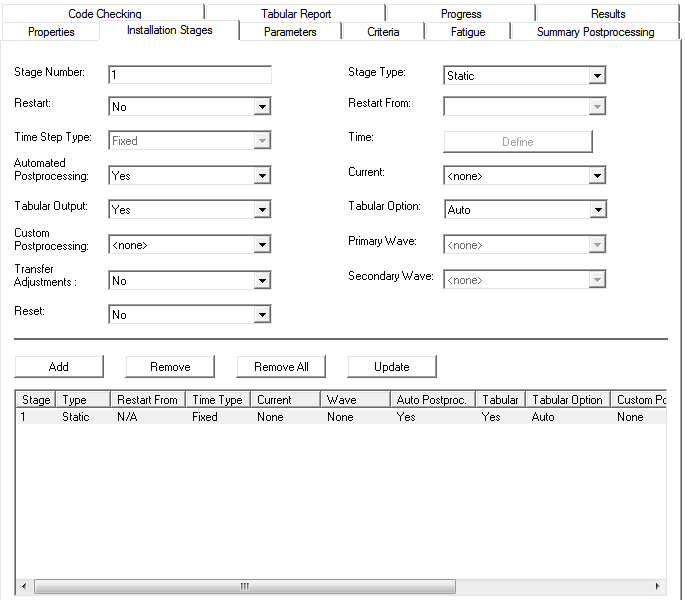
Static Analysis Specified
It is normal to work with static stages and get them fully working before specifying any dynamic stages, but for convenience you can specify a dynamic stage at this point for Stage 2. This will be a restart from Stage 1; that is, using the configuration solved in Stage 1 as the starting point for the dynamic analysis. First, change the Stage Number to 2, switch Stage Type to Dynamic and change Restart to Yes. PipeLay now knows this is a dynamic stage restarting from the previous one. Use the Current, Primary Wave and Secondary Wave drop-down lists to associate environmental conditions with this dynamic stage.
As a dynamic stage, you’ll have to set some parameters relating to the length of the analysis and the time-stepping algorithm to use. The default Time Step Type of Fixed will work in very many cases and can be left. Click on the Time – Define button to specify appropriate dynamic analysis time variables (such as start and end times, time-step, ramp type, ramp time etc.)
Once all the data is input, just click Add to include the dynamic analysis in the list of stages. The Installation Stages tab will then look as shown in the figure below.

Dynamic Analysis Specified
That is all that you need to do on the Installation Stages tab. For this normal lay analysis you don’t need to use the Parameters tab at all; there is no parameter we want to directly vary from stage to stage. You will generally want to use the Criteria tab however. For this example, you will use the Criteria tab to request a particular static tension at the vessel connection in Stage 1, and have PipeLay achieve this by adjusting the position of the pipe end on the seabed.
The figure below shows the Criteria tab before any criteria are specified. The left-hand side allows you to define your criteria and the right-hand side allows you to tell the program what it can adjust to achieve them.
Looking at the left-hand side first, many of the default options are already suitable for the example being discussed. Specifically, you do want to nominate Stage 1, you do want Tension as your criterion and you want the criterion to be the tension in a Pipe Section component (presuming the Model has been defined in the usual manner). You only have to choose which Pipe Section using the Comp Name drop-down list.
You want to specify tension at the vessel connection point and Location allows you to do that. Its value depends on how you added the pipe section to the model. If you said that the pipe section’s start point was the fixed connection point on the seabed, Location should be End. On the other hand, if you started the pipe section at the vessel connection point, choose Start.
Finally, click on Values – Define to specify the tension you want to achieve; this is defined in terms of a range. The tighter the range, the harder PipeLay will have to work to satisfy your criterion.
On the right-hand side, Fixed Connection Point is already selected and the Name drop-down shows all fixed connection points in the Model component. Select the one representing the end of the pipe. You will also need to use the User Vector drop-down list to select an Axis System component. This tells PipeLay the direction or axis along which you want the fixed connection to be moved. The figure below shows how the Criteria tab might look after this specification.

Completed Criteria Tab
This almost completes the data specification for a normal lay analysis. You might want to specify some dynamic analysis parameters on the Properties tab (data you specify there applies to all dynamic analysis stages). The Properties tab should look something like the figure below.
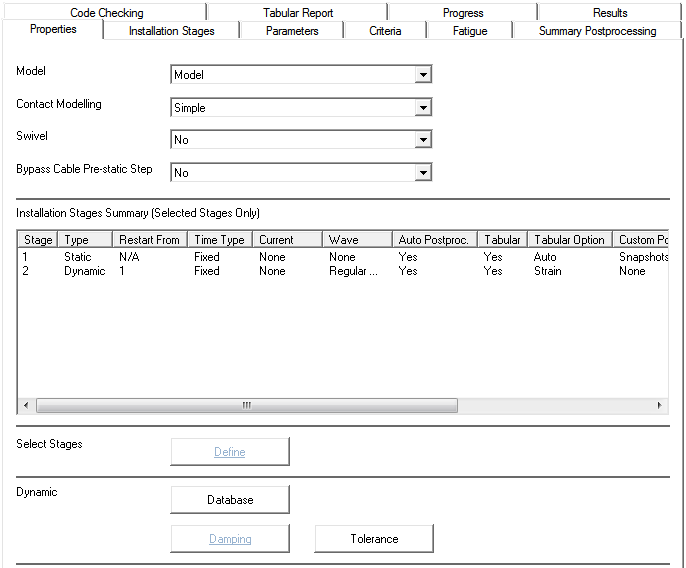
Updated Properties Tab
You should notice two things have changed on this tab. Firstly, the Installation Stages Summary section reflects the stages defined on the Installation Stages tab; this allows for a quick visual inspection. Secondly, data has apparently been added behind the Select Stages – Define button, although you did not directly enter any. If you click on this button, the Analysis - Select Stages dialog is displayed as shown in the figure below.
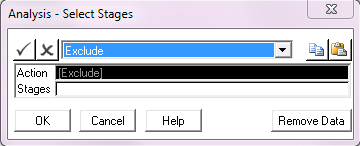
Select Stages Dialog
The Select Stages dialog is useful when you want to define a complicated analysis with multiple stages, multiple changes of parameters, multiple criteria and so on. On any given occasion, you might want to run only a small number of the stages you have defined. When you are defining stages on the Installation Stages tab, PipeLay automatically fills in the Analysis - Select Stages dialog and marks all stages for inclusion in your analysis by default. If necessary, you can edit the Select Stages dialog to select Exclude as the Action and then type the stage numbers that you want to exclude in the Stages text box. You use a comma to separate the stage numbers or you can use a dash to specify a range of values. For example, you can type 1,2,5-9 in the Stages text box.
In the example we have just described, you have just two analysis stages, the second restarting from the first, so you do not want to exclude either stage.
Finally, you might choose to specify some level of damping for the dynamic run. Either way, that completes the data specification for a typical analysis.
Actually running the analysis is straight-forward; you simply use the ![]() icon in the Home tab. PipeLay automatically switches the display to the Progress tab to enable you to monitor the progress of the analysis. The Progress tab provides details on what stage of the analysis is running, and (for the dynamic run) an estimate of how long it will take to complete. The operation is intuitive and straight-forward.
icon in the Home tab. PipeLay automatically switches the display to the Progress tab to enable you to monitor the progress of the analysis. The Progress tab provides details on what stage of the analysis is running, and (for the dynamic run) an estimate of how long it will take to complete. The operation is intuitive and straight-forward.
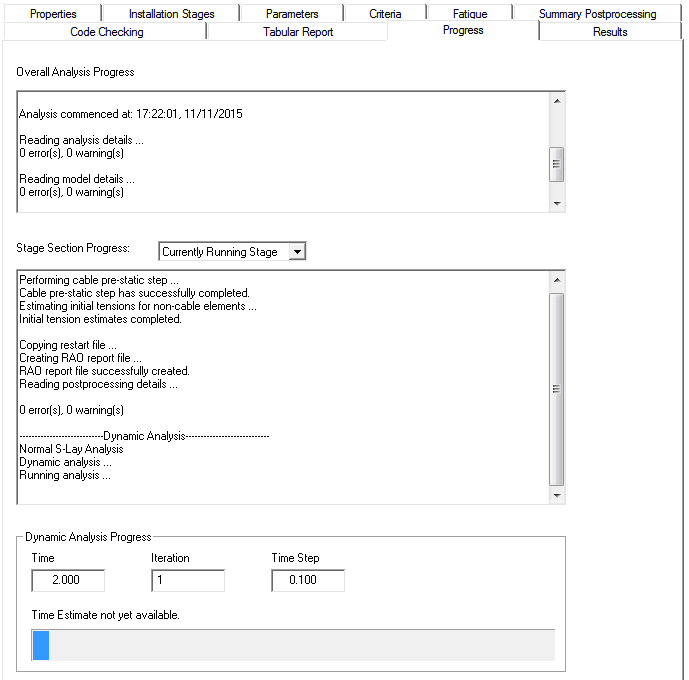
Example Progress Tab
Further details of all of the outputs and options on the Progress tab are given covered in a different article.
The final tab of interest in this brief overview of the Analysis component is the Results tab, an example of which is shown in the figure below.
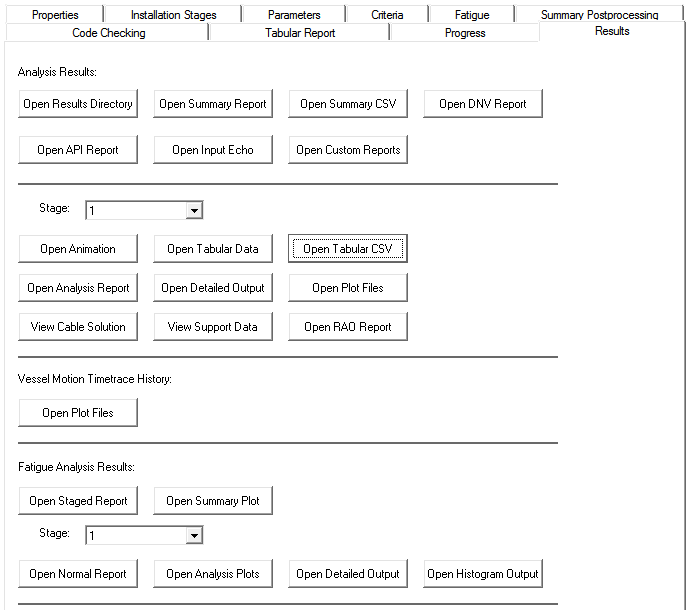
Example Results Tab
Again the operation is intuitive and straight-forward. Clicking on any button except Open Results Directory automatically opens a PipeLay output file or files, whether it is a report, a plot file or files, or a Dynamic Display or animation file. Open Results Directory launches Windows™ Explorer to display the contents of the PipeLay results directory in full. 'Results Tab - Analysis Results', lists the various types of output produced by the program, and ‘Additional Modules’ deals in detail with the PipeLay modules for viewing and manipulating this output.